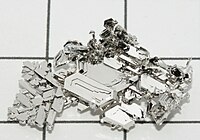
Photo from wikipedia
Combine and conquer Platinum (Pt)–group metals, which are scarce and expensive, are used for the demanding oxygen reduction reaction (ORR) in hydrogen fuel cells. One competing approach for reducing their… Click to show full abstract
Combine and conquer Platinum (Pt)–group metals, which are scarce and expensive, are used for the demanding oxygen reduction reaction (ORR) in hydrogen fuel cells. One competing approach for reducing their use is to create nanoparticles with earth-abundant metals to increase their activity and surface area; another is to replace them with metals such as cobalt (Co) in carbide or nitride sites. Chong et al. thermally activated a Co metal-organic framework compound to create ORR-active Co sites and then grew PtCo alloy nanoparticles on this substrate. The resulting catalyst had high activity and durability, despite its relatively low Pt content. Science, this issue p. 1276 Active cobalt sites and platinum-cobalt nanoparticles are combined in a highly active and durable oxygen reduction catalyst. Achieving high catalytic performance with the lowest possible amount of platinum is critical for fuel cell cost reduction. Here we describe a method of preparing highly active yet stable electrocatalysts containing ultralow-loading platinum content by using cobalt or bimetallic cobalt and zinc zeolitic imidazolate frameworks as precursors. Synergistic catalysis between strained platinum-cobalt core-shell nanoparticles over a platinum-group metal (PGM)–free catalytic substrate led to excellent fuel cell performance under 1 atmosphere of O2 or air at both high-voltage and high-current domains. Two catalysts achieved oxygen reduction reaction (ORR) mass activities of 1.08 amperes per milligram of platinum (A mgPt−1) and 1.77 A mgPt−1 and retained 64% and 15% of initial values after 30,000 voltage cycles in a fuel cell. Computational modeling reveals that the interaction between platinum-cobalt nanoparticles and PGM-free sites improves ORR activity and durability.
Journal Title: Science
Year Published: 2018
Link to full text (if available)
Share on Social Media: Sign Up to like & get
recommendations!